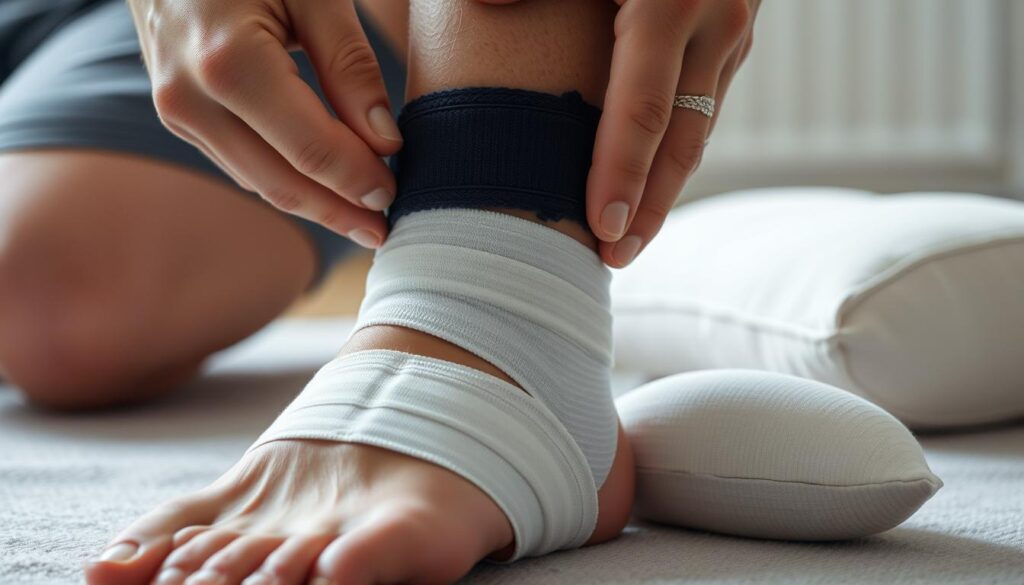Ankle sprains can be frustrating, but knowing the right treatment is key. These injuries often happen during sports and physical activities1. Quick action is vital for healing and avoiding long-term issues1.
Sprains vary in severity, affecting recovery time. Healing can take weeks or months, depending on the damage1. Doctors use X-rays, MRI, and CT scans to check the injury’s extent2.
The RICE method is crucial for treating sprained ankles. It stands for rest, ice, compression, and elevation1. Use this approach in the first 24 hours after injury.
Over-the-counter pain relievers can help manage discomfort. They support your recovery process and make healing more comfortable2.
Key Takeaways
- Ankle sprains can occur during various physical activities
- Different injury grades determine recovery time
- Immediate treatment is crucial for proper healing
- Multiple diagnostic tools can assess ankle injuries
- RICE method is essential for initial injury management
Understanding Sprained Ankles
Ankle injuries can really mess up your day-to-day life. They’re tricky and can limit how you move around. Knowing more about ankle sprains helps you handle them better.
What is a Sprained Ankle?
A sprained ankle happens when the ligaments in your ankle get stretched or torn. Most ankle sprains involve the outer ligaments. These injuries can be mild stretches or full tears3.
Common Causes and Risk Factors
Ankle sprains often occur during sudden movements in physical activities. High-impact sports raise your risk of getting a sprain4.
- Uneven surfaces
- Improper footwear
- Previous ankle injuries
- Lack of strength or flexibility
Symptoms to Watch For
Spotting ankle sprain symptoms is key for proper Ligament Healing. Look out for these signs:
- Pain and tenderness
- Swelling
- Bruising
- Difficulty bearing weight
- Warmth in the affected area4
Ankle Braces can provide critical support during recovery and help prevent further injury.
Doctors group sprains into three levels based on how bad they are. Most sprains don’t need surgery if treated right. Ankle Rehabilitation Exercises can really help3.
Your quick response and appropriate treatment can significantly impact your recovery time and prevent long-term complications.
Immediate Actions for Sprained Ankle
Quick and proper treatment can make a big difference in sprained ankle recovery. The right steps can reduce discomfort and promote healing. Learn about effective sprained ankle pain management.
The R.I.C.E. method is crucial for managing your ankle injury. It provides a complete strategy for ankle swelling reduction and initial care5.
Understanding the R.I.C.E. Method
- Rest: Avoid putting weight on the injured ankle for 48 to 72 hours5.
- Ice: Apply cold compress for 15-20 minutes, 4-8 times daily to reduce swelling5.
- Compression: Use an elastic bandage to minimize fluid accumulation5.
- Elevation: Keep your ankle raised above heart level to decrease swelling5.
Pain Management and Recovery
Over-the-counter pain relievers can help manage discomfort during recovery5. Ibuprofen and acetaminophen are good options. Sprains can take days to months to heal, depending on their severity5.
When to Seek Medical Help
While many sprains can be treated at home, sometimes you need a doctor. Seek help if:
- Your pain is severe
- You cannot bear weight on the ankle
- Symptoms do not improve after two or three days5
Remember, proper initial treatment can significantly impact your recovery and reduce the risk of long-term complications.
Effective Treatment Options
Recovering from a sprained ankle needs a smart healing plan. Physical therapy is key to getting back on your feet. Athletes in basketball or soccer need focused rehab for ankle injuries6. Healing can take five days to six weeks, depending on how bad the sprain is6.
Ankle support is vital during recovery. Physical therapy exercises help stabilize your foot, usually starting after two to three weeks7. Your doctor might suggest an ankle brace or orthotic for support7. Pain relief often comes from drugs like ibuprofen67.
Home care can boost professional treatment. Compression bandages and cooling methods can help healing7. Be wary of herbal ointments, as they lack proven benefits7. Most mild sprains allow normal walking within a week7.
Good care is crucial. About one in 10 people may develop ankle instability if swelling isn’t managed well6. Preventing future injuries is your best defense. Seek advice from sports medicine clinics to avoid recurring sprains.
Strengthen your ankles, warm up properly, and wear supportive shoes. These steps can greatly lower your risk of future injuries. Remember, prevention is always better than cure.
FAQ
How do I know if I have a sprained ankle?
What is the RICE method for treating a sprained ankle?
How long does it take to recover from a sprained ankle?
When should I see a doctor for a sprained ankle?
Can I prevent future ankle sprains?
What types of exercises help rehabilitate a sprained ankle?
Do I need surgery for a sprained ankle?
Source Links
- Sprained Ankle: Treatment & Symptoms – https://www.massgeneralbrigham.org/en/patient-care/services-and-specialties/sports-medicine/conditions/foot-ankle/ankle-sprain
- Sprained ankle – Diagnosis and treatment – https://www.mayoclinic.org/diseases-conditions/sprained-ankle/diagnosis-treatment/drc-20353231
- Sprained Ankle – OrthoInfo – AAOS – https://orthoinfo.aaos.org/en/diseases–conditions/sprained-ankle/
- Sprained Ankle Causes, Symptoms, and Treatment | UPMC – https://www.upmc.com/services/orthopaedics/conditions/ankle-sprain
- Sprain: First aid – https://www.mayoclinic.org/first-aid/first-aid-sprain/basics/art-20056622
- Sprained Ankle: Proper Treatment | Foot & Ankle Conditions – https://www.hss.edu/condition-list_sprained-ankle.asp
- Ankle sprains: Learn More – What are the treatment options for ankle sprains? – InformedHealth.org – https://www.ncbi.nlm.nih.gov/books/NBK279550/
